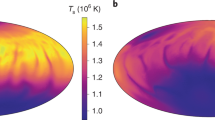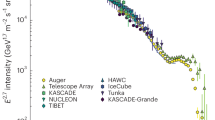Abstract
ELECTRODYNAMIC processes may be responsible for both the creation and acceleration of charged particles near condensed objects. For pulsars1–3, the strong magnetic fields associated with the spinning neutron star generate substantial electric fields which may, in turn, create electron–positron pairs. In some models3 the escaping ultrarelativistic positrons create further pairs by curvature radiation, and can explain many features of the pulsar radiation. Models for double radio sources have also been proposed, where a magnetised rotator, say a spinar4 or the magnetised accretion disk around a supermassive black hole5–7, accelerates5,6 and possibly creates7 relativistic charged particles. Theories invoking an aligned rotator also provide a natural way of creating well collimated supersonic beams at very small distances from the powerhouse, obviating the need for hydrodynamic confinement by flattened gas clouds7,8. We propose here a variation of this idea in which high energy beams of neutrons can be used to transport energy to relatively large distances from an active central powerhouse assuming that electromagnetic acceleration mechanisms are important. Decay back into charged particles allows radiation to recommence further away from such a generator than in other models.
This is a preview of subscription content, access via your institution
Access options
Subscribe to this journal
Receive 51 print issues and online access
$199.00 per year
only $3.90 per issue
Buy this article
- Purchase on Springer Link
- Instant access to full article PDF
Prices may be subject to local taxes which are calculated during checkout
Similar content being viewed by others
References
Goldreich, P. & Julian, W. H. Astrophys. J. 157, 869–880 (1969).
Gunn, J. E. & Ostriker, J. P. Astrophys. J. 160, 979–1002 (1970).
Ruderman, M. A. & Sutherland, P. G. Astrophys. J. 196, 51–72 (1975).
Morrison, P. Astrophys. J. Lett. 157, L73 (1969).
Lovelace, R. J. E. Nature 262, 649–652 (1976).
Blandford, R. D. Mon. Not. R. astr. Soc. 176, 465–481 (1976).
Blandford, R. D. & Znajek, R. L. Mon. Not. R. astr. Soc. 179, 433–456 (1977).
Blandford, R. D. & Rees, M. J. Mon. Not. R. astr. Soc. 169, 395–415 (1974).
Wiita, P. J. Astrophys. J. (in the press).
Stoeger, S. J. thesis, Cambridge Univ. (1977).
Kellerman, K. I. et al. Astrophys. J. Lett. 197, L113–L116 (1975).
Pauliny-Toth, I. I. K. et al. Nature 259, 17–20 (1976).
Longair, M. S., Ryle, M. & Scheuer, P. A. G. Mon. Not. R. astr. Soc. 164, 243–270 (1973).
Bell, A. R. Mon. Not. R. astr. Soc. 182, 147–156 (1978).
Author information
Authors and Affiliations
Rights and permissions
About this article
Cite this article
EICHLER, D., WIITA, P. Neutron beams in active galactic nuclei. Nature 274, 38–39 (1978). https://doi.org/10.1038/274038a0
Received:
Accepted:
Published:
Issue Date:
DOI: https://doi.org/10.1038/274038a0
Comments
By submitting a comment you agree to abide by our Terms and Community Guidelines. If you find something abusive or that does not comply with our terms or guidelines please flag it as inappropriate.



